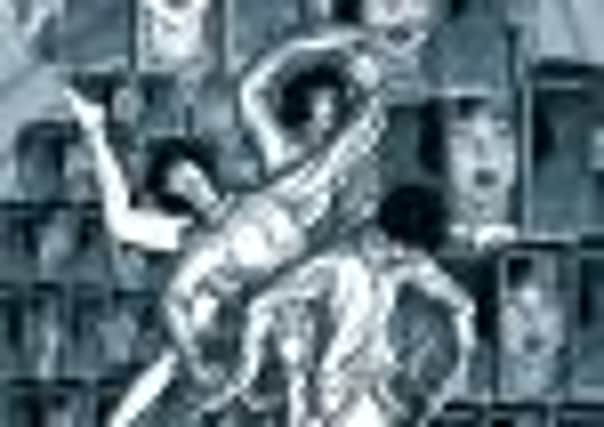Graphic novel review: Dotter Of Her Father’s Eyes


Mary and Bryan Talbot’s volume makes an impressive addition to these ranks, but as one would expect from the creator of Alice in Sunderland and The Tale of One Bad Rat there is rather more going on than mere memoir.
The Talbots set up a parallel pair of relationships: that between Mary and her father, the James Joyce scholar James Atherton (the author of the remarkable study The Books At The Wake) and that between Joyce himself and his daughter Lucia. Atherton was every inch the domineering father of the post-war period, whose authoritarianism was backed up by sarcasm.
Advertisement
Hide AdAdvertisement
Hide AdThe initial trigger for the book is when Mary finds her father’s old ID card – in a piece of synchronicity it is the anniversary of Joyce’s birth – and almost spontaneously responds with the line from the Wake, “my cold mad feary father”. Joyce seems initially the more attractive and liberal parent; bohemian, comical, a European intellectual rather than a provincial and disappointed schoolteacher. But his treatment of Lucia turns out to be even more damaging and reactionary.
Lucia was a talented dancer, studying with Isadora Duncan and Lubov Egarova. Certainly Lucia’s mother, Nora, and possibly her father did not exactly approve. Lucia began to show signs of mental illness in the 1930s (around the same time as her infatuation with her father’s secretary, Samuel Beckett, started to fray). Her family put her into therapy with Carl Jung in 1934, and she was committed to an asylum in 1935. Lucia died, in St Andrews’ Hospital in Northampton in 1982. She had spent almost her entire adult life in care.
Mary Talbot became a widely-respected academic, and the author of Language and Gender and All The World and Her Husband: Women in Twentieth Century Consumer Culture. Throughout the double narrative we see the ways, sometimes conscious, sometimes unconscious, sometimes aggressively, sometimes slyly, that female identity is constrained and constructed.
There are some very deft little touches where she comments on her husband’s artwork – the fact her mother would have never worn a frilly apron; the way he doesn’t segregate the sexes in the classroom scenes. This is within the context of a wider awareness, from education to ballet lessons to obstetrics, on how women’s lives were directed into the “unnatural”. There can’t be many more frightening and saddening moments in graphic novels than the account of the birth of a first child, and the terse note “without anaesthetic”.
Talbot’s artwork is as distinctive and rewarding as ever, making full use of collage and pastiche. There is a wonderful panel where Lucia’s descent into madness reprises the movements of her experimental dance. The scenes from the Joyce’s life are rendered, cleverly, in greys while the Atherton’s lives are mostly in sepia tones. It makes the use of colour incredibly effective: a green Penguin biscuit looks more precious than an emerald; a purple bag conveys more about the liberation of the Sixties than a shelf of sociological studies. That there is no colour at all in the Joyce sections makes a stark point about the differences in their lives. One tiny quibble would be the depiction of Beckett, who for some reason looks more like TS Eliot in some panels. The gradual change in James Atherton’s looks is, however, frightening in its slow unpeeling of cruelty. The title – taken from the Wake as well – is reflected in the use of points for eyes, and when Talbot does drawn them as full eyes, it marks moments of crucial importance.
The relationship between Lucia and her father’s work is an ongoing and vexed question. He referred to the Wake as a “sounddance”, and the so-called Rainbow Girls are a clear allusion to Lucia’s dance troupe. More worryingly, in the dream that is the Wake, the central character is tormented by incestuous thoughts about his daughter Issy (whose personality is split into a mirror-twin: Jung’s diagnosis of Lucia was schizophrenia). The Talbots – quite wisely – don’t go too far into the psychoanalytical readings of the Wake, though there are hints for those with eyes to see. In another one of those weird synchronicities, Lucia Joyce died on the same day as James Atherton’s birthday.
In The Importance of Being Earnest, Oscar Wilde wrote: “Children begin by loving their parents; after a time they judge them; rarely, if ever, do they forgive them.” Mary Talbot might not wholly have forgiven James, but in the funeral scene, where she realises other people may have had a quite different opinion of him, we get a bittersweet second-cousin to forgiveness.
Advertisement
Hide AdAdvertisement
Hide AdDotter of Her Father’s Eyes is an accomplished and emotionally satisfying work. It almost made me hope that Mary and Bryan Talbot might collaborate on a graphic novel version – suitably abridged! – of Finnegans Wake itself.
• Dotter Of Her Father’s Eyes
Mary M Talbot and Bryan Talbot
Jonathan Cape, 94pp, £14.99